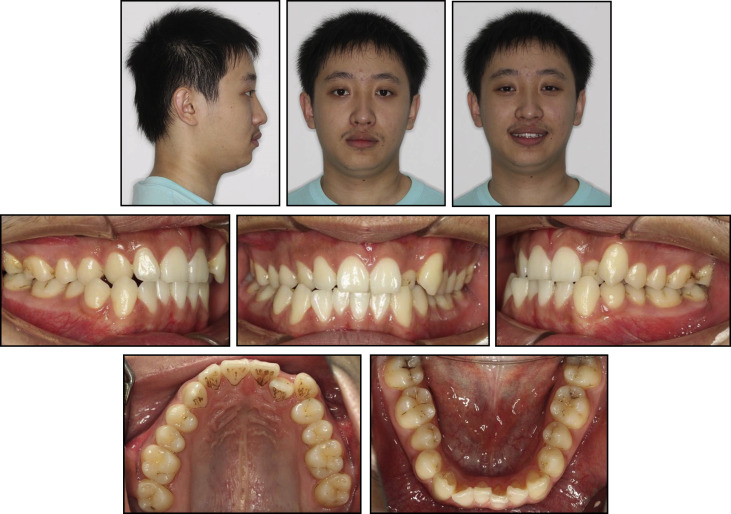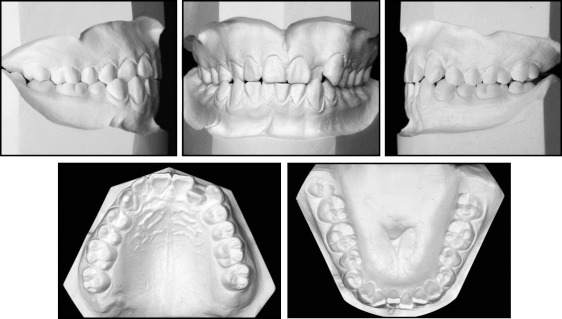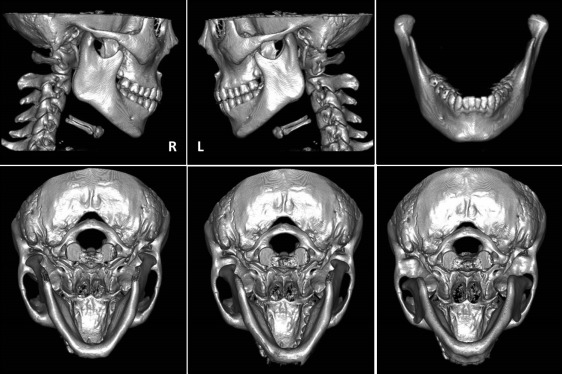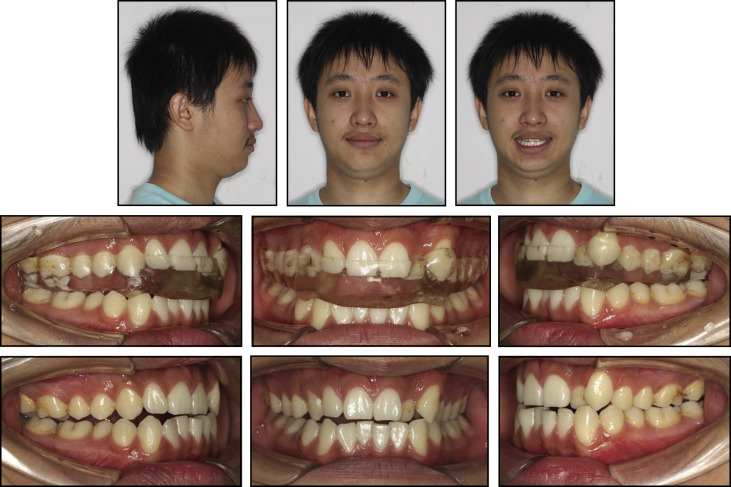A mandibular functional shift usually poses a challenge for orthodontists, especially when it is accompanied by a temporomandibular disorder (TMD). Accurate diagnosis and complete elimination of the etiologic factors are the keys to an esthetic and stable outcome. This article describes the treatment of a teenager with a mandibular functional shift, TMD symptoms, and facial asymmetry resulting from an asymmetric maxillary arch form and multiple crossbites as occlusal interferences. The treatment alternatives and effective orthodontic techniques are described. To optimize the treatment results and prevent the recurrence of the TMD after treatment, the displaced mandible was repositioned by full-time wearing of a splint for 10 months. Adhesive bite-blocks were used to maintain the newly acquired mandibular position during fixed appliance treatment. A series of nickel-titanium and stainless steel rectangular archwires was placed in the maxillary arch to reshape it for 8 months after alignment. Finally, the displaced mandible was steadily seated into its physiologic position with fine occlusion. The TMD symptoms disappeared and never relapsed after treatment. At 2 years 3 months of retention, there was good stability. The combined splint and fixed appliance approach resolved an intractable clinical problem and avoided using additional appliances. An esthetic, functional, and stable outcome was achieved that satisfied both the patient and his parents.
Highlights
- •
Accurate diagnosis and complete elimination of the etiologic factors are the keys.
- •
Adhesive bite-blocks were used to maintain the newly acquired mandibular position.
- •
The combination of splint and fixed appliance treatment is an effective method for treating mandibular functional shift.
A mandibular functional shift (MFS) is an intractable type of malocclusion for orthodontists. It is clinically characterized by facial asymmetry, dental midline discrepancy, and unilateral crossbite, and it is highly correlated to temporomandibular disorder (TMD).
An MFS challenges every clinician as a multifactorial problem; displacement of the mandible is just a clinical manifestation. The etiologic factors include skeletal asymmetry, dental arch asymmetry, occlusal interferences, disc displacement, neuromuscular disorders, or a combination of these. Hence, it is not easy to make an accurate diagnosis for each patient. Furthermore, an MFS is difficult to treat orthodontically and obtain satisfactory and stable results. Orthognathic surgery is also needed when there is a severe skeletal deformity.
MFS is relatively common in patients with malocclusion. There are 7% to 23% of people with a unilateral crossbite, and an MFS is a common condition among them, with a prevalence of 80% to 97%. Thus, it is necessary for every orthodontist to know the correct way to handle the situation, especially when there is no skeletal asymmetry but the patient has TMD and multiple crossbites. If handled incorrectly, these patients may suffer from the complicated treatment process, and the final result will be compromised, with a high risk of relapse. The aim of this article is to present a patient with this type of MFS and the necessary orthodontic treatments to overcome this difficult problem. This treatment modality resolved the MFS by eliminating the multiple crossbites, TMD symptoms, and dental arch asymmetry, and it improved esthetics and function, satisfying both the patient and parents.
Diagnosis and etiology
The patient was a 16-year-old Chinese boy whose chief complaint was his marked facial asymmetry, with a mandibular shift to the right side and tooth crowding ( Fig 1 ). His parents claimed that his face was symmetric years ago, but neither his parents nor the boy could remember when the asymmetry had occurred. No injury to his jaw or relevant family history was found, but he had experienced pain in the joint areas and in the muscles of mastication during last few years. He also had clicking sounds in his temporomandibular joints (TMJs) for about 3 to 4 years, and they had been aggravated half a year previously.

Clinically, the boy had a straight profile and normal facial proportions. A 4.5-mm discrepancy was found in the midlines of the maxillary and mandibular arches. The midline of the maxillary arch was deviated about 1 mm to the left of the facial midline, whereas the midline of the mandibular arch was deviated 3.5 mm to the right ( Fig 2 ). As compensatory adaption for the right-side shifted mandible, all maxillary left teeth were lingually inclined, but no inclination on the occlusal plane was found. Crossbites were found in the maxillary left lateral incisor and the mandibular right lateral incisor, canine, and first premolar; the maxillary arch form was asymmetric with some depression in the right canine region. There was mild crowding in both arches, the maxillary left lateral incisor was blocked lingually, and the maxillary and mandibular arch length discrepancies were –5 and –4 mm, respectively. The maxillary and mandibular incisors had edge-to-edge relationships with straight inclination. His style of opening was like the character “ㄣ,” with a right-side lateral shift at the beginning and the end of jaw opening, but the mandibular midline came back to the center at the late stage of jaw opening. The clicking happened at the early and late stages of opening on both TMJs.

Dental cast analysis showed an asymmetric maxillary arch form; the distance from the midline of the maxillary arch to the cusp of the right canine was 2.5 mm shorter than that of the other side ( Fig 2 ). The dental arch widths in the canine and premolar regions of both arches were nearly equal; this indicated transverse discrepancies in these regions. No transverse discrepancy was found in the posterior segment, and the Bolton index was normal. Magnetic resonance imaging (MRI) showed anterior disc displacement with reduction in both joints, and computed tomography (CT) showed a narrow posterior joint space in the right TMJ, indicating that the condyle was not seated at its optimal position ( Fig 3 ). The 3-dimensional (3D) CT image and panoramic radiograph showed a symmetric mandible, and no remarkable skeletal deformity was found ( Fig 4 ). The lateral cephalometric evaluation showed a skeletal Class I jaw relationship (ANB, 2.7°) and straight incisors in both arches (IMPA, 88.5°; UI-SN, 96.5°; U1-L1, 137.9°) ( Table ).


| Angular (°) | Norm ∗ (±SD) | Pretreatment (16 y 1 mo) | Posttreatment (18 y 4 mo) |
|---|---|---|---|
| SNA | 82.8 (±4.0) | 80.9 | 82.1 |
| SNB | 80.1 (±3.9) | 78.2 | 79.1 |
| ANB | 2.7 (±2.0) | 2.7 | 3.0 |
| Facial angle | 87.3 (±3.1) | 86.5 | 87.0 |
| FMA | 27.1 (±5.2) | 29.8 | 24.0 |
| U1-SN | 104.3 (±5.8) | 96.5 | 112.4 |
| FMIA | 55.0 (±6.0) | 64.8 | 59.6 |
| IMPA | 93.0 (±6.2) | 88.5 | 94.1 |
| U1-L1 | 124.6 (±8.2) | 137.9 | 120.9 |
| OP-SN | 16.1 (±5.0) | 19.2 | 16.4 |
According to the examination above, the patient was diagnosed with an MFS to the right with TMD and dental compensation. Since no skeletal deformity was found, the etiologic factor for the facial asymmetry was considered to be the MFS.
Treatment objectives
The treatment objectives were to (1) reposition the laterally shifted mandible and improve the TMD condition, (2) coordinate the dental midlines, (3) eliminate the transverse discrepancy of the maxilla, (4) correct and coordinate the maxillary and mandibular arch forms, (5) align and level the teeth, (6) establish ideal overbite and overjet relationships to obtain a functional occlusion, and (7) improve the facial asymmetry.
Treatment objectives
The treatment objectives were to (1) reposition the laterally shifted mandible and improve the TMD condition, (2) coordinate the dental midlines, (3) eliminate the transverse discrepancy of the maxilla, (4) correct and coordinate the maxillary and mandibular arch forms, (5) align and level the teeth, (6) establish ideal overbite and overjet relationships to obtain a functional occlusion, and (7) improve the facial asymmetry.
Treatment alternatives
Several treatment options were considered. The first option was 1 phase of treatment with a removable bite-block combined with intermaxillary elastics during the orthodontic treatment until the crossbites were eliminated. This option would not sufficiently improve the facial asymmetry and would depend highly on the patient’s compliance. The dental decompensation would be subjective and inaccurate. The TMD symptoms might also relapse as a result of long-term intermaxillary elastics use. Although the final result might be acceptable, the long-term stability and the health of the TMJs would be doubtful. On the other hand, the second option of 2 phases of treatment would be much more effective for improving facial symmetry and solving the TMD problems because little elastics use would be needed. An experienced clinician may accurately diagnose all the problems without a 3D CT image or MRI and achieve excellent results without splint treatment before placing the braces. But for most orthodontists, the first phase of splint treatment prior to fixed appliance treatment would contribute to the accuracy of dental decompensation and establish a functional occlusion with healthy TMJs, leading to long-term stablility. However, a long treatment time would be inevitable. The third option was TMJ surgery and orthodontic treatment. This option could correct the anterior disc displacement of the right joint and improve facial asymmetry, but it would leave a scar on the face and have many surgical risks. Furthermore, the long-term stability of TMJ surgery remains uncertain.
No extraction plan was considered because of the patient’s nonextraction request, although this option might have resulted in a slightly more protrusive profile.
Treatment plan
The patient and his parents selected the following treatment plan after the consultation.
- 1.
Michigan splint treatment before the orthodontic process to include correction of the laterally shifted mandible and improvement of the TMD condition. Adhesive bite-blocks would be placed before bracket bonding to maintain the mandibular position while occluding and to enable the crossbite corrections.
- 2.
Orthodontic treatment would include alignment and decompensation of the maxillary and mandibular teeth, arch coordination, coordination of the dental midlines with the midlines of the jaws, and elimination of the transverse discrepancy in the maxillary anterior region. The adhesive bite-blocks would be partially ground at subsequent visits and removed when ideal overbite and overjet relationships were obtained.
- 3.
Retention.
Treatment progress
Treatment began with full-time wearing of a splint. A full maxillary coverage splint with a flat occlusal plane and an inclined plane in the anterior section was made ( Fig 5 ). We modified the splint design with the vertical dimension opened 3.5 mm in the posterior teeth, which completely eliminated the effects of the original occlusion on the TMJs. The splint was made according to a centric bite registration, and the maxillary flat acrylic occlusal pad touched every buccal cusp or incisal edge of the mandibular teeth. The inclined plane was made to cover the mandibular anterior teeth; this created normal anterior and lateral guidance.





